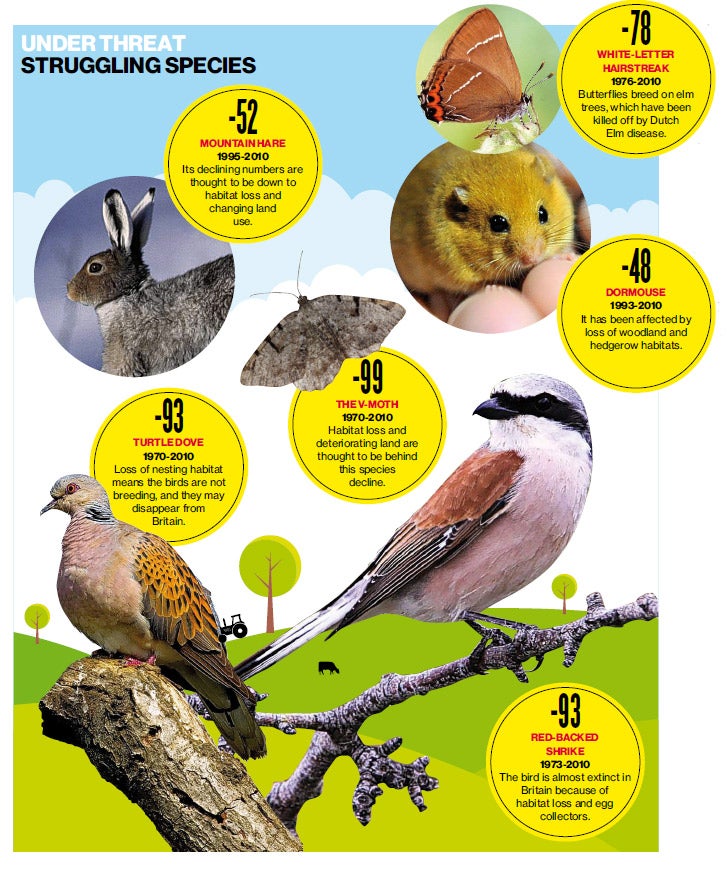Natural disaster: Government's new index reveals huge decline for Britain’s most endangered wildlife
‘FTSE Index’ for threatened species is launched as new analysis reveals a 60 per cent decline since the 1970s

Britain’s most endangered species have declined by almost 60 per cent since the 1970s, according to a new Government tool launched to track the nation’s wildlife.
Click image above to enlarge graphic
The official analysis looks at the how the populations of more than 200 native species – including birds, bats, moths, butterflies, hares and dormice – have changed over the last 40 years.
While the Government has previously published statistics for individual wildlife groups, this is the first time it has pulled together information on all the nation’s “priority” wildlife at the same time. The new index has described as a “FTSE Index for threatened wildlife” .
The new statistics reveal that priority species have declined on average by 58 per cent since 1970. The government has described this as a “statistically significant decrease”.
Around 70 per cent of the priority species have declined in the last forty years, according to the new data, which shows that moth species have faced the hardest time – declining in abundance by around 88 per cent.
Climate change and habitat loss are thought to be key factors, according to experts. Butterfly numbers have also declined by around 40 per cent compared to 1970 levels.
Richard Gregory, head of species monitoring at the RSPB, said the new indicator showed a “steady and very worrying decline”.
But he added that this could be improved with the new indicator. “What this new official biodiversity statistic does is act as an indicator of the health of our countryside. Every year the Government will be publishing these figures in the same way that they publish school league tables and crime statistics.”
He added: “We hope they will be a powerful new tool in the fight to halt the loss of our threatened native wildlife.”
Thanks to conservation efforts, bird populations have fared better than the invertebrates, with population numbers increasing by an average of around 17 per cent over the last forty years.
The osprey, red kite, white-tailed eagle and marsh harrier have done particularly well, according to the index. Mammals have also seen an estimated 16 per cent increase.
Several species groups have not been included, including amphibians, reptiles, fish, fungi or plants.
But conservationists estimate that the latter are not faring much better, with 97 per cent of the UK’s wild flower meadows lost and one in five of all UK flowering plants species threatened with extinction.
Mr Gregory added that the RSPB will be working with the Government to ensure that data for these species can be included in future to “build a full picture of the state of our wildlife”.
The State of Nature report published earlier this year found that 60 per cent of UK species assessed were in decline, with over one in ten threatened with distinction.
Joan Edwards, head of living seas at The Wildlife Trust, said she hoped “this official indicator for priority species takes that one step further and ensures that the problems facing our native species are factored into Government decision-making”.
A Defra spokesperson said biodiversity indicators had seen improvements, including increasing bat and wintering water-bird populations, as well as air quality improvements and increased protection at sea.
She added: “More is being done to protect our wildlife than ever before and the latest indicators show that we are making improvements. We’ve invested £7.5m to create Nature Improvement Areas, more farmland is now managed for wildlife and more of our seas are protected.”
Join our commenting forum
Join thought-provoking conversations, follow other Independent readers and see their replies
Comments
Bookmark popover
Removed from bookmarks